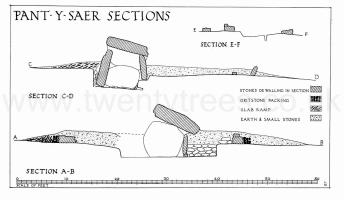Text this colour links to Pages. Text this colour links to Family Trees. Text this colour are links that are disabled for Guests.
Place the mouse over images to see a larger image. Click on paintings to see the painter's Biography Page. Mouse over links for a preview. Move the mouse off the painting or link to close the popup.
Stuart Piggott 1910-1996 is in Archaeologists.
On 28th May 1910 Stuart Piggott was born at Petersfield, Hampshire.
In 1927 Stuart Piggott (age 16) was employed as an assitant at Reading Museum.
In 1928 Stuart Piggott (age 17) joined the Royal Commission on the Ancient and Historical Monuments of Wales.

Archaeologia Cambrensis 1933 Pages 185-228. This leads me to the unhappily necessary task of referring to the previous excavations of the tomb. Following the digging of some treasure seekers in 1874, who reported the finding only of bones, excavation was undertaken in the same year by the Rev. Wynn Williams and Messrs. T. and R. Prichard. A report by Mr. T. Prichard is to be found in Archaeologia Cambrensis, 1875, pages 344—348, accompanied by two plans, which I reproduce here (Figs. 2 and 3) together with a sketch (Fig. 4), which Mr. Stuart Piggott (age 22) has very kindly made for me, showing a north to south section of the chamber reconstructed from the description and measurements given in the report.
Antiquity Volume 9 Issue 33. Stukeley, Avebury and the Druids. By Stuart Piggott (age 24).
Antiquity 1936 Volume 10 Issue 40 Pages 417-427. The Recent Excavations at Avebury [Map] by Alexander Keiller (age 45) and Stuart Piggott (age 24).
On 12th November 1936 Stuart Piggott (age 26) and Celia Margaret Preston were married.
3rd December 1955. Nature. Obituaries. Source
Mr. Alexander Keiller.
ALEXANDER KEILLER, who died at the end of September at the age of sixty-five, was one of the long line of distinguished amateur British archæologists which goes back to Aubrey and Stukeley. Of these perhaps the greatest was Pitt-Rivers, on whom Keiller, like him with leisure and abundant means at his disposal, admittedly modelled his own work.
While still in his early thirties, Keiller carried out a systematic survey of stone circles and allied monuments in north-east Scotland, making accurate plans and detailed descriptions of each site. A summary account of this work was presented as a paper to the British Association at its Aberdeen meeting in 1934.
In 1925, however, he embarked on the programme of excavation and field-work with which his name will be inseparably associated. He acquired and began excavations on Windmill Hill, near Avebury in north Wiltshire, and continued these annually until 1929, revealing in detail the first extensive Neolithic settlement to be explored in Britain. The material was housed in a museum in his London house, where it was at the disposal of students, and as a result the earliest Neolithic culture of southern Britain, taking its name from the type-site, was defined and clarified.
From Windmill Hill to the Avebury monuments themselves was an inevitable step, and in 1933 Keiller began a systematic excavation programme with the oxarnination of the northern part of the West Kennet Circle itself. Avenue, continuing until 1938 within the Great Circle itself. He moved his residence to Avebury Manor, and re-housed his museum within its grounds, making it and the excavated portions of the monument available to the public. He adopted a policy of imaginative but judicious conservation and, restoration of the Avebury monuments, and systematically purchased land to preserve these and their surroundings; as a result it was eventually possible for the whole area to be acquired by the National Trust and the Ancient Monuments Department of the Ministry of Works.
Keiller's outstanding contribution to contemporary British archreology was his insistence on high standards of discipline and accuracy in excavation and field-work, and his realization from the first of the value of scientific techniques as applied to archreo logical material. He early appreciated the potential ities of air photography, collaborating with Crawford in the "Wessex from the Air" survey, and even discussing with Eckener the possibility of using the Graf Zeppelin for a similar but even more ambitious scheme. At Windmill Hill he insisted on a full study of the faunal and floral remains in their archreological context. But above all it is to Keiller that we owe the inception of the systematic study of British prehistoric stone artefacts by petrographical means, which, following his lead, is now yielding information of the highest importance on manufacture and trade in the early second millennium B.C. Alec Keiller was an enthusiast in the best sense; full of ideas, stimulating and highly individual. Archæology, like other academic disciplines, can only benefit from the impact of such men.
STUART PIGGOTT (age 45)
![]() Become a Member via our Buy Me a Coffee page to read more.
Become a Member via our Buy Me a Coffee page to read more.
On 23rd September 1996 Stuart Piggott (age 86) died.